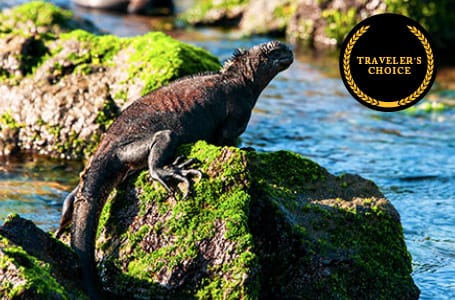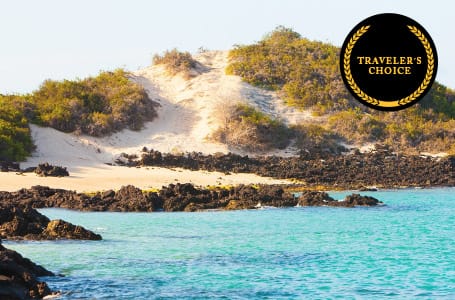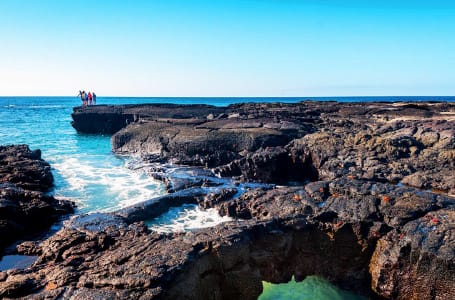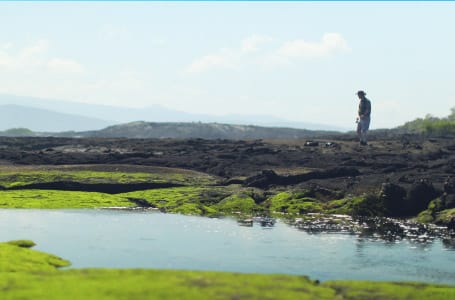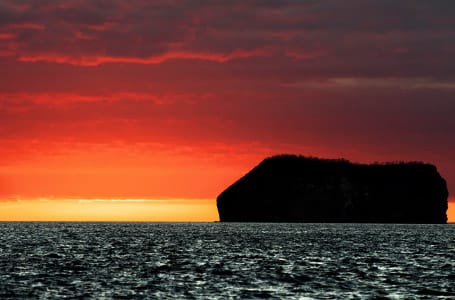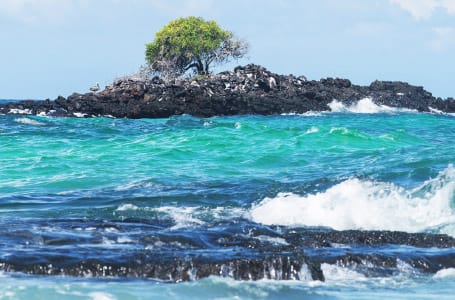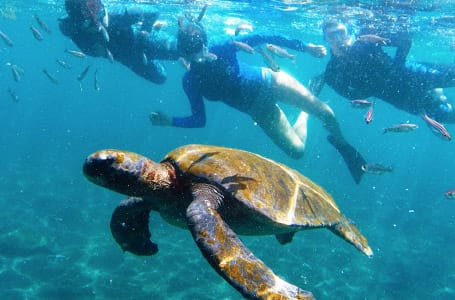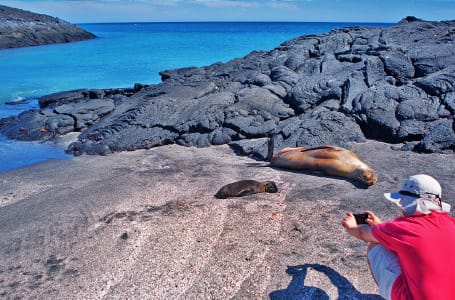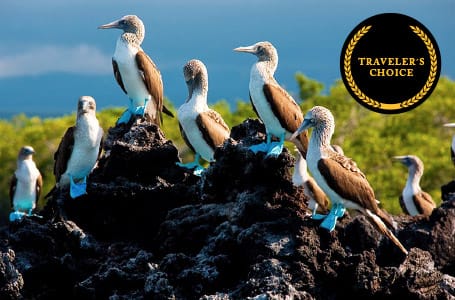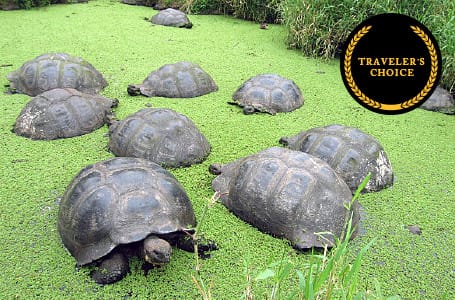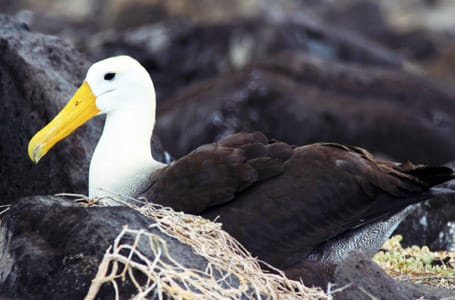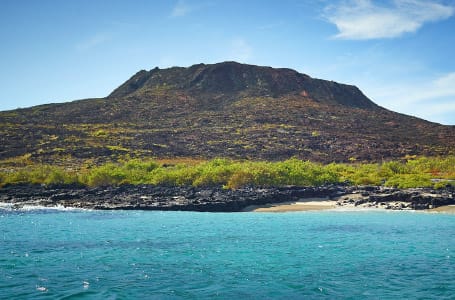- Home >
- Travel Guide >
- Galapagos Islands Travel Guide >
- Galapagos Climate and Weather
Thanks to the confluence of cold water currents from the west and the south, the Galapagos archipelago has an uncharacteristically dry and moderate climate for the tropics and is generally classified as sub-tropical. This makes Galapagos travel a year-round vacation option. Galapagos weather is considered equatorial, cooled by the Humboldt Current, and is characterized by two main seasons:
- The warm, wet season (Late December to June)
- The cool, dry season (Late June to December)
Read more on the best time to visit the Galapagos Islands below.
Late December to June is considered the warm and wet season, with March and April usually being the hottest and wettest months. Around December, the trade winds fall and the climactic equator (located north of the geographic equator) shifts south toward the Galapagos, causing the westward-flowing current to slow, reducing the upwelling and allowing warmer water from the Panama Current to bathe the archipelago. Galapagos climate is characterized by rain clouds that form when the inversion layer breaks down, and the air warms and rises, resulting in daily afternoon showers. Even in this season; however, the low elevations receive only limited rain.
This season, also known as the "garua season" runs from late June to December, when it is relatively cool and dry with more overcast skies and occasional drizzle or mist (garua) during the day. August is the coolest month. During this dry season, Galapagos weather is pleasant, the water temperature is lower and there are often clouds on the higher elevations. Visibility is usually lower in the water due to plankton bloom, but this combination of conditions brings in the whale sharks and there is a lot more activity in the water and food is abundant. Because Galapagos climate is not too hot during this season, it is also the breeding period for many sea birds and shore birds, marine iguanas, sea lions and fur seals.
El Niño is a disruption of the oceanic and atmospheric systems off the coast of South America that causes unusually warm water temperatures, a shift in the direction of the winds, changes in currents, and significantly increased rain. The increased rainfall leads to the destructive flooding on the eastern Pacific, while at the same time causing drought in the western Pacific, all the way to Australia. This phenomenon is predicted by monitoring changes in temperature on the surface of the sea, wind conditions, and currents near Ecuador and Peru.
During El Niño, trade winds slow in the central and western Pacific causing the warmest water to shift to the east, which in turn results in major changes in atmospheric circulation around the globe, forcing weather changes throughout the world. When the warm water shifts east, the coldwater thermocline layer near South America drops lower into the ocean. The surface water temperature rises significantly and the supply of colder, nutrient-rich water is cut off.
Download our detailed month-by-month guide on what animals to see and what weather to expect.
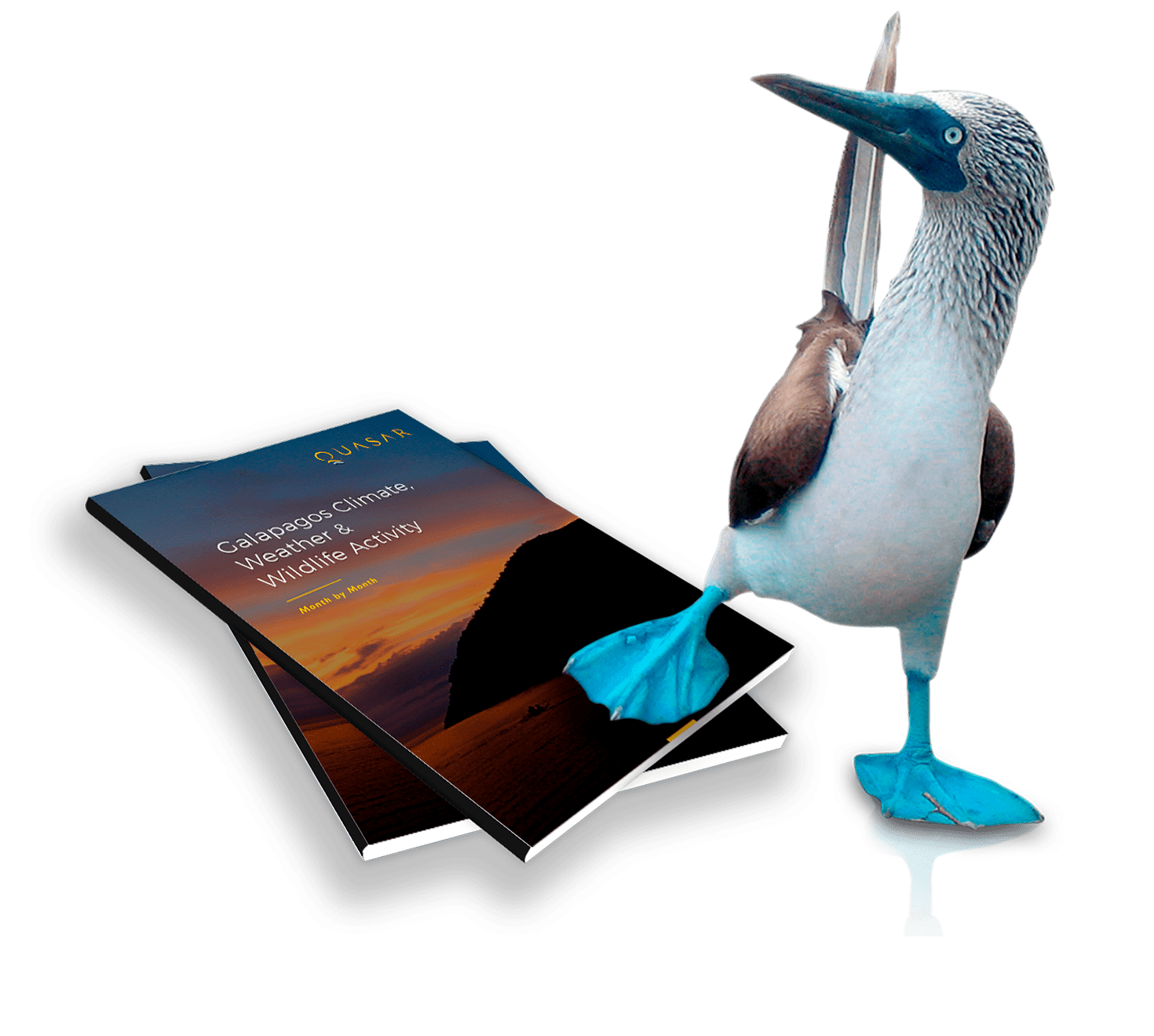
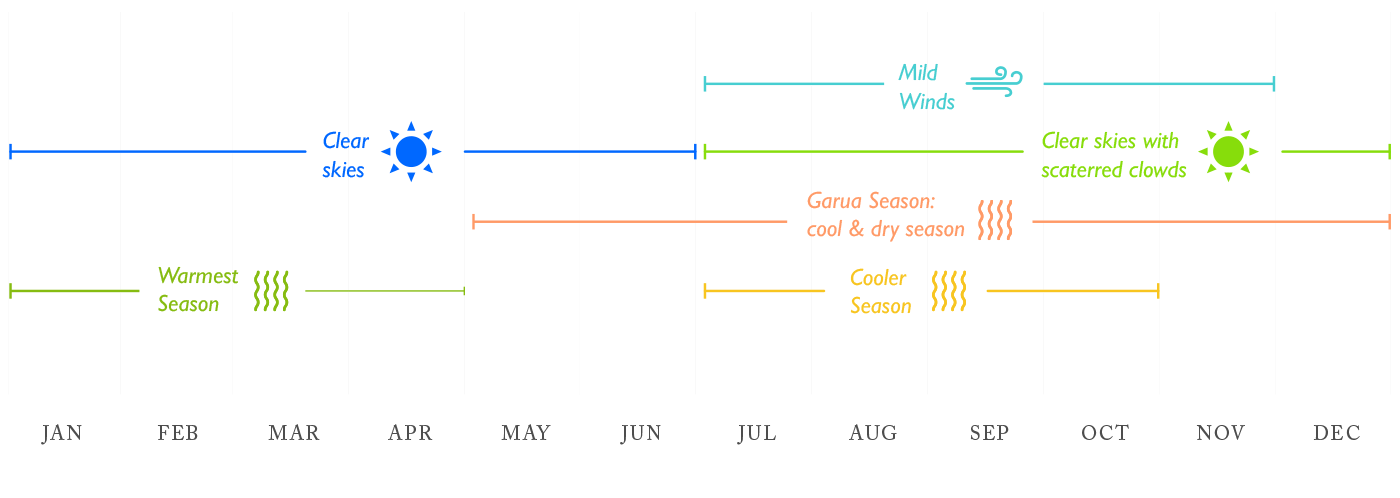
(slide to view)
Galapagos Weather Month by Month
- Best month for snorkeling with penguins
- Great Underwater visibility
- Warm sunny days, with lots of hours of clear skies
- Water temperatures are some of the warmest all year
Climate conditions:
- Air Temp (Max / Min): 30/22C, 86/72F
- Hours of clear skies: 5.3
- Average Rainfall: 2.5cm, 1.0in (in the highlands)
- Average Water Temperature: 24.5C / 76F
Animals Mating / Breeding:
- Red-footed boobies and masked boobies breeding and nesting (year-round)
- Green Sea turtles nesting
- Marine Iguanas and Land Iguanas mating
- Magnificent and Great Frigate birds nesting (year-round on North Seymour Only)
- Tortoises laying eggs (in the wild)
- Flightless Cormorants, Penguins and Greater Flamingoes breeding and nesting (year-round, depending on food supply)
------------
Special Notes:
- Best underwater visibility (along with Feb & March)
- The sun is very intense during this month. We Recommend sun-block SPF 30 or higher.
- Additional information about January in the Galapagos.
- Best Underwater visibility (along with March)
- Warm sunny days. Most hours of clear skies of any month
- Water temperatures are some of the warmest all year
- Giant tortoises are laying eggs in the wild
Climate conditions:
- Air Temp (Max / Min): 30 / 24C, 86 / 75F
- Hours of clear skies: 7.5
- Average Rainfall: 2.5cm, 1.0in (in the highlands)
- Average Water Temperature: 25C / 77F
Animals Mating / Breeding:
- Red-footed boobies and masked boobies breeding and nesting (year-round)
- Green Sea turtles nesting
- Marine Iguanas and Land Iguanas mating
- Magnificent and Great Frigate birds nesting (year-round on North Seymour Only)
- Tortoises laying eggs (in the wild)
- Flightless Cormorants, Penguins and Greater Flamingoes breeding and nesting (year-round, depending on food supply)
------------
Special Notes:
- Best underwater visibility (along with Feb & March)
- The sun is very intense during this month. We Recommend sun-block SPF 30 or higher.
- Additional information about February in the Galapagos.
- Best Underwater visibility (along with Jan & Feb)
- Water temperature is the highest all year (along with April)
- Land Iguanas begin mating (male fighting spectacles)
- Highlands are very green and lush
Climate conditions:
- Air Temp (Max / Min): 31 / 24C, 88 / 75F
- Hours of clear skies: 6.0
- Average Rainfall: 5.1cm, 2.0in (in the highlands)
- Average Water Temperature: 25C / 77F
Animals Mating / Breeding:
- Red-footed boobies and masked boobies breeding and nesting (year-round)
- Green Sea turtles nesting
- Marine Iguanas and Land Iguanas mating
- Magnificent and Great Frigate birds nesting (year-round on North Seymour Only)
- Great Frigate birds mating and nesting on Genovesa (Tower) Island
- Tortoises laying eggs (in the wild)
- Flightless Cormorants, Penguins and Greater Flamingoes breeding and nesting (year-round, depending on food supply)
------------
Special Notes:
- Best underwater visibility (along with Jan & Feb)
- Rainy season reaches its peak in the highlands
- Water temperature is the highest all year (until April)
- The sun is very intense during this month. We recommend sun-block SPF 30 or higher.
- Additional information about March in the Galapagos.
- Water temperature is the highest all year (along with March)
- Flamingos breeding and nesting (bright colors)
- Highlands are very green and lush
- Some of the clearest skies all year
Climate conditions:
- Air Temp (Max / Min): 31 / 24C, 88 / 75F
- Hours of clear skies: 7.5
- Average Rainfall: 3.8cm, 1.5in (in the highlands)
- Average Water Temperature: 25C / 77F
Animals Mating / Breeding:
- Red-footed boobies and masked boobies breeding and nesting (year-round)
- Green sea turtles nesting
- Marine Iguanas and Land Iguanas mating
- Magnificent and Great Frigate birds nesting (year-round on North Seymour Only)
- Waved albatross begin mating and nesting
- Great Frigate birds mating and nesting on Genovesa (Tower) Island
- Tortoises laying eggs (in the wild)
- Flightless Cormorants, Penguins and Greater Flamingoes breeding and nesting (year-round, depending on food supply)
------------
Special Notes:
- Rainy season reaches its peak in the highlands
- Water temperature is the highest all year
- The sun is very intense during this month. We recommend sun-block SPF 30 or higher.
- Additional information about April in the Galapagos.
- Cooler season begins (days are not as hot)
- Most pleasant weather all year (along with June)
- Waved Albatross arrive to Galapagos and begin nesting
- Humboldt Current gets stronger (nutrient rich waters attract marine life)
Climate conditions:
- Air Temp (Max / Min): 28 / 22C, 82 / 72F
- Hours of clear skies: 5.2
- Average Rainfall: 1.9cm, 0.75in (in the highlands)
- Average Water Temperature: 24.5C / 76F
Animals Mating / Breeding:
- Red-footed boobies and masked boobies breeding and nesting (year-round)
- Green Sea turtles nesting
- Marine Iguanas and Land Iguanas mating
- Waved albatross nesting
- Magnificent and Great Frigate birds nesting (year-round on North Seymour Only)
- Great Frigate birds mating and nesting on Genovesa (Tower) Island
- Tortoises laying eggs (in the wild)
- Flightless Cormorants, Penguins and Greater Flamingoes breeding and nesting (year-round, depending on food supply)
------------
Special Notes:
- Beginning of the Garua season (cool dry season - until December)
- Along with the month of June, this month offers the most pleasant weather. The intense hot climate of the earlier months begins to cool off, but there are still plenty of hours of clear skies.
- Additional information about May in the Galapagos.
- Most pleasant weather all year (along with May)
- Flightless Cormorants start nesting (depending on food supply)
- Stronger Humboldt Current makes marine life active (great for snorkeling)
- Little rainfall in the highlands
Climate conditions:
- Air Temp (Max / Min): 26 / 21C, 79 / 70F
- Hours of clear skies: 4.4
- Average Rainfall: 0.6cm, 0.25in (in the highlands)
- Average Water Temperature: 23C / 73F
Animals Mating / Breeding:
- Red-footed boobies and masked boobies breeding and nesting (year-round)
- Waved albatross nesting
- Marine Iguanas and Land Iguanas mating
- Magnificent and Great Frigate birds nesting (year-round on North Seymour Only)
- Flightless Cormorants, Penguins and Greater Flamingoes breeding and nesting (year-round, depending on food supply)
------------
Special Notes:
- Beginning of the Garua season (cool dry season - until December)
- Along with the month of May, this month offers the most pleasant weather. The intense hot climate of the earlier months begins to cool off, but there are still plenty of hours of clear skies.
- Additional information about June in the Galapagos.
- California Sea Lions start breeding (sea lion pups throughout the islands)
- Stronger Humboldt Current makes marine life active (great for snorkeling)
- Red Footed Boobies begin nesting
- Whale and dolphin spotting becomes more common
Climate conditions:
- Air Temp (Max / Min): 26 / 20C, 79 / 68F
- Hours of clear skies: 2.8
- Average Rainfall: 1.3cm, 0.50in (in the highlands)
- Average Water Temperature: 22C / 72F
Animals Mating / Breeding:
- Blue-footed boobies begin nesting
- Red-footed boobies and masked boobies breeding and nesting (year-round)
- Waved albatross nesting
- Magnificent and Great Frigate birds nesting (year-round on North Seymour Only)
- Start of California sea lion breeding season
- Flightless Cormorants, Penguins and Greater Flamingoes breeding and nesting (year-round, depending on food supply)
------------
Special Notes:
- The presence of the Humboldt Current begins to strengthen, makingnutrients in the water more abundant and marine life more active.Snorkeling is great during this period.
- Dolphin and Whale spotting, particularly on our crossing to Fernan dina Island, becomes more common.
- Along with the month of August, this month has more pronounced winds. However, winds in Galapagos never get too strong, as compared to other destinations like the Caribbean.
- Additional information about July in the Galapagos.
- Blue Footed Boobies mating and nesting (dancing rituals)
- Stronger Humboldt Current makes marine life active (great for snorkeling)
- Whale and dolphin spotting is more common throughout the islands
- California Sea Lions begin breeding
Climate conditions:
- Air Temp (Max / Min): 26 / 19C, 79 / 66F
- Hours of clear skies: 3.3
- Average Rainfall: 0.6cm, 0.25in (in the highlands)
- Average Water Temperature: 21.5C / 71F
Animals Mating / Breeding:
- Blue-footed boobies nesting
- Red-footed boobies and masked boobies breeding and nesting (year-round)
- Waved albatross nesting
- Magnificent and Great Frigate birds nesting (year-round on North Seymour Only)
- California sea lions breeding
- Fur Sea lions begin breeding
- Tortoises (in Santa Cruz Island only) lay eggs in the wild)
- Flightless Cormorants, Penguins and Greater Flamingoes breeding and nesting (year-round, depending on food supply)
------------
Special Notes:
- The presence of the Humboldt Current begins to strengthen, making nutrients in the water more abundant and marine life more active. Snorkeling is great during this period.
- Dolphin and Whale spotting, particularly on our crossing to Fernan dina Island, becomes more common.
- Along with the month of July, this month has more pronounced winds. However, winds in Galapagos never get too strong, as compared to other destinations like the Caribbean.
- Additional information about August in the Galapagos.
- Whale and dolphin watching is at its best (along with Oct)
- Frigate birds start mating (beautiful displays)
- Best Snorkeling all year (along with Oct)
- California Sea Lions in full breeding (lots of sea lion pups)
Climate conditions:
- Air Temp (Max / Min): 26 / 19C, 79 / 66F
- Hours of clear skies: 2.9
- Average Rainfall: 2.5cm, 1.3cm, 0.50in (in the highlands)
- Average Water Temperature: 22C / 72F
Animals Mating / Breeding:
- Blue-footed boobies nesting
- Red-footed boobies and masked boobies breeding and nesting (year-round)
- Waved albatross nesting
- Magnificent and Great Frigate birds nesting (year-round on North Seymour Only)
- California sea lions breeding
- Fur Sea lions breeding
- Flightless Cormorants, Penguins and Greater Flamingoes breeding and nesting (year-round, depending on food supply)
------------
Special Notes:
- The presence of the Humboldt Current is strong, making nutrients in the water more abundant and marine life more active. Snorkeling is excellent during this month and swimming with sea-lion pups is very common.
- Dolphin and Whale spotting, particularly on our crossing to Fernan dina Island, is very common.
- Winds are still pronounced during this month.
- Additional information about September in the Galapagos.
- Whale and dolphin watching is at its best (along with Sept)
- Giant Tortoises are laying eggs in the wild
- Best Snorkeling all year (along with Oct)
- Fur Sea Lions are breeding (lots of fur sea lion pups)
Climate conditions:
- Air Temp (Max / Min): 26 / 20C, 79 / 68F
- Hours of clear skies: 3.8
- Average Rainfall: 0.6cm, 0.25in (in the highlands)
- Average Water Temperature: 22.5C / 73F
Animals Mating / Breeding:
- Blue-footed boobies nesting
- Red-footed boobies and masked boobies breeding and nesting (year-round)
- Waved albatross nesting
- Magnificent and Great Frigate birds nesting (year-round on North Seymour Only)
- California sea lions breeding
- Fur Sea lions breeding
- Tortoises (in Santa Cruz Island only) lay eggs in the wild
- Flightless Cormorants, Penguins and Greater Flamingoes breeding and nesting (year-round, depending on food supply)
------------
Special Notes:
- The presence of the Humboldt Current continues to be strong, making nutrients in the water more abundant and marine life more active. Snorkeling is great during this period and swimming with sea-lion pups is very common.
- Dolphin and Whale spotting, particularly on our crossing to Fernan dina Island, is very common.
- Winds are still pronounced during this month.
- Additional information about October in the Galapagos.
- Green sea turtles begin mating
- Whale and dolphin watching still great
- Active marine life and great snorkeling
- Days start to get warmer
Climate conditions:
- Air Temp (Max / Min): 26 / 21C, 79 / 70F
- Hours of clear skies: 3.5
- Average Rainfall: 1.3cm, 0.50in (in the highlands)
- Average Water Temperature: 23C / 73F
Animals Mating / Breeding:
- Blue-footed boobies nesting
- Red-footed boobies and masked boobies breeding and nesting (year-round)
- Waved albatross nesting
- Magnificent and Great Frigate birds nesting (year-round on North Seymour Only)
- Green Sea turtles begin mating
- California sea lions breeding
- Fur Sea lions breeding
- Flightless Cormorants, Penguins and Greater Flamingoes breeding and nesting (year-round, depending on food supply)
------------
Special Notes:
- The presence of the Humboldt Current is strong, making nutrients in the water more abundant and marine life more active. Snorkeling is very good during this month and amazing marine encounters are very common.
- Dolphin and Whale spotting is very common in the Bolivar Channel crossing on our way to Fernandina Island.
- Winds are still present during this month.
- Additional information about November in the Galapagos.
- Official start of the warm season (days get warmer)
- Humboldt Current loses strength (waters get warmer)
- More clear skies
- Masked Boobies begin nesting
Climate conditions:
- Air Temp (Max / Min): 27 / 22C, 81 / 72F
- Hours of clear skies: 4.0
- Average Rainfall: 1.3cm, 0.50in (in the highlands)
- Average Water Temperature: 22.5C / 73F
Animals Mating / Breeding:
- Blue-footed boobies nesting
- Red-footed boobies and masked boobies breeding and nesting (year-round)
- Waved albatross nesting
- Magnificent and Great Frigate birds nesting (year-round on North Seymour Only)
- Green sea turtles begin mating
- Marine Iguanas and Land Iguanas begin mating
- California sea lions breeding
- Fur Sea lions breeding
- Flightless Cormorants, Penguins and Greater Flamingoes breeding and nesting (year-round, depending on food supply)
------------
Special Notes:
- This month marks the start of the warm season in Galapagos and the Humboldt Current loses strength. There are plenty of hours of clear skies.
- This is the start and the end of the breeding and mating seasons for many animals in Galapagos, making wildlife encounters very attractive.
- The sun starts to get more intense during this month. We recom mend guests to use sun-block SPF 30 or higher, at least for the first few days.
- Additional information about December in the Galapagos.

(slide to view)

(slide to view)

